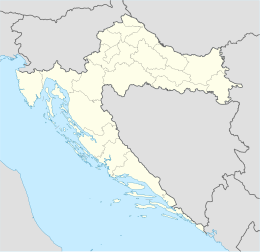
Dugi Otok is the seventh largest island in the Adriatic Sea, part of Croatia. It is located off the Dalmatian coast, west of Zadar. It is the largest and westernmost of the Zadarian Islands, and derives its name from its distinctive shape: it is 44.5 km long by 4.8 km wide, with an area of 114 square kilometres (44 sq mi). Its elevation reaches 300 m; and many of its higher portions contain stands of Maritime Pine.
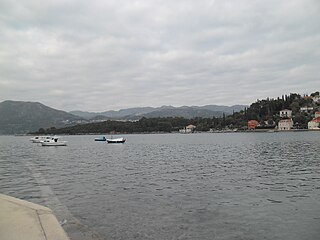
The island of Koločep is one of the three inhabited Elaphiti Islands situated near the city of Dubrovnik with an area of 2.44 square kilometres. Koločep is the southernmost inhabited island in Croatia. In the 2011 census, the population of the island was 163.
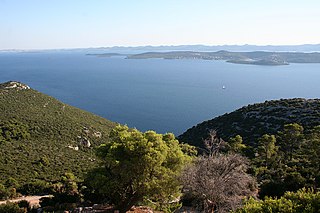
Ugljan is a Croatian island and the first in the Zadar Archipelago. It is located northwest of the island of Pašman and southeast of the islands of Rivanj and Sestrunj. Separated from the mainland by the Zadar Channel, it is connected with the island of Pašman by the Ždrelac Bridge spanning over the Ždrelac Strait. Area 50.21 km2 (19.39 sq mi), population 6,049 (2011), length 22 km (14 mi), width up to 3.8 km (2.4 mi).

Rava is an island in the Croatian part of the Adriatic Sea. It is situated in the Zadar Archipelago, between Iž and Dugi Otok, 16 nautical miles (30 km) from Zadar. Its area is 3.6 km2, and it has a population of 117. The only settlements on the island are Vela Rava and Mala Rava. The coast of the island is very indented with 13 bays and 15.45 kilometres of coastline. The island is composed of dolomite. The primary industries are agriculture and fishing.

Sveti Andrija is an island in the Croatian part of the Adriatic Sea. It is part of the Elaphiti Islands archipelago, Dalmatia and is situated 6 nautical miles (11 km) from Dubrovnik, 3 nautical miles (6 km) from Koločep, 2 nautical miles (4 km) from Lopud and 4 nautical miles (7 km) from Šipan. The island is 475 metres long, and its maximal width is 130 metres, while its coastline is 1,130 m (3,710 ft) long. The total area of the island is 53,757 square metres, with a maximum height elevation of 57 m (187 ft) above sea level.

Sveti Andrija, often called Svetac, is an island in the Croatian part of the Adriatic Sea. It is situated 14 nautical miles (26 km) from Komiža. It is uninhabited, although it used to have permanent residents.

Mrduja is an uninhabited island in the Croatian region of Dalmatia. It is located in the Adriatic Sea, within the Split Gates between the islands of Brač and Šolta, about 400 m from Cape Zaglav near Milna. The island is nearer to Brač than to Šolta: a legend goes that the inhabitants of Brač and those of Šolta wrangled over whom the island belonged to so they used a rope in an attempt to pull it from one side of the Split Channel to the other. The people of Brač won the tug of war.
Sušac is a small rocky island in the Adriatic Sea with an area of 4.03 km2, and 16.4 km of coastline southwest of Korčula and Lastovo, on the halfway to the island of Vis, in Croatia. The coast consists of slopes and cliffs over 100 m tall, but the opposite side features a natural harbour. A 19th-century lighthouse is built on top of the island. The island is also known for its little lake, which is connected to the sea through a siphon 15 m deep.

Ruda is an uninhabited islet in Croatia, part of the Elaphiti Islands archipelago off the coast of southern Dalmatia, near Dubrovnik. It is located between the islands of Lopud and Šipan. Its area is 0.296 km2 and its coastline is 2.37 km long. The highest point on Ruda is 81 m high.
Tajan is an uninhabited islet in Croatia, part of the Elaphiti Islands archipelago off the coast of southern Dalmatia, near Dubrovnik. It is located near the island of Jakljan. Its area is 0.111 km2 and its coastline is 1.41 km long.
Olipa is an uninhabited islet in Croatia, part of the Elaphiti Islands archipelago off the coast of southern Dalmatia. It is the westernmost isle in the Elaphites. Olipa is mostly rocky and partially covered in forest. A stone square tower is located on the south side of the isle, which serves as a lighthouse. The lighthouse is used for maritime routes passing through the passages of Veliki Vratnik and Mali Vratnik.
Kornat is an island in the Croatian part of the Adriatic Sea, in central Dalmatia. With an area of 32.44 km2 it is the 16th largest island in Croatia and the largest island in the eponymous Kornati islands archipelago. It is part of the Kornati National Park, which is composed of a total of 89 islands, islets and rocks.

Prežba is a small inhabited island in the Croatian part of the Adriatic Sea, located northwest of the island of Lastovo in southern Dalmatia. It is connected to Lastovo by a bridge at the village of Pasadur on Lastovo. Prežba's area is 2.81 km2, but its coastline is 14.23 km long, due to the large number of coves on the island. Its highest peak is 136 m above sea level and there is a lighthouse on the south side of the island, across the bay from Ubli. The island was used by the Yugoslav People's Army as a military base containing a tunnel and tunnel for ships.

Prvić is an uninhabited island in the Croatian part of the Adriatic Sea, located in the Kvarner Gulf. It is the largest of the so-called Senj Islands, a group of small islands and islets located off the coast of the mainland city of Senj, lying between the larger islands of Krk and Rab. Other significant islands in the Senj group are Sveti Grgur and Goli Otok, along with a number of islets and rocks, which are all uninhabited. Prvić has an area is 12.76 square kilometres (4.93 sq mi), which makes it the largest uninhabited Croatian island and 30th largest overall.

Topography of Croatia is defined through three major geomorphological parts of the country. Those are the Pannonian Basin, the Dinaric Alps, and the Adriatic Basin. The largest part of Croatia consists of lowlands, with elevations of less than 200 metres above sea level recorded in 53.42% of the country. Bulk of the lowlands are found in the northern regions of the country, especially in Slavonia, itself a part of the Pannonian Basin plain. The plains are interspersed by the horst and graben structures, believed to break the Pannonian Sea surface as islands. The greatest concentration of ground at relatively high elevations is found in Lika and Gorski Kotar areas in the Dinaric Alps, but such areas are found in all regions of Croatia to some extent. The Dinaric Alps contain the highest mountain in Croatia—1,831-metre (6,007 ft) Dinara, as well as all other mountains in Croatia higher than 1,500 metres. Croatia's Adriatic Sea mainland coast is 1,777.3 kilometres long, while its 1,246 islands and islets encompass further 4,058 kilometres of coastline—the most indented coastline in the Mediterranean. Karst topography makes up about half of Croatia and is especially prominent in the Dinaric Alps, as well as throughout the coastal areas and the islands.
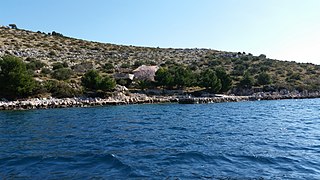
Sit is an uninhabited Croatian island in the Adriatic Sea located between Žut and Pašman. Its area is 1.77 km2 (0.68 sq mi).
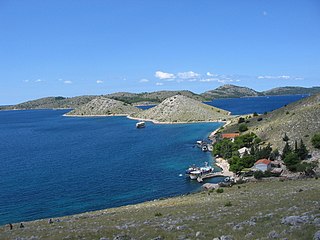
Katina is a Croatian island in the Adriatic Sea located between Dugi Otok to the north and Kornat to the south. Its area is 1.17 km2 (0.45 sq mi).

Smokvica Vela is an uninhabited Croatian island in the Adriatic Sea located southeast of Kornat. Its area is 1.05 km2 (0.41 sq mi). Lojena Bay is located on the southeast part of the island, exposed to the jugo wind and sheltered from other winds. The northern tip of the island is marked by a lighthouse.

Stražica Lighthouse on the island of Prvić in the Adriatic Sea was built in 1875 and consists of a small stone house and a 5-metre (16 ft) tall lighthouse tower. A crew of lightkeepers were stationed on the island until it was made fully automated in 1974. In 1993 the natural gas-powered system was replaced with solar panels and is today remotely controlled by Plovput, the state-owned company for maritime traffic which controls the entire network of Croatian lighthouses. Until 1974, the lighthouse crew were the only inhabitants of Prvić, and until the early 2000s it was believed that Prvić held the distinction of being the largest uninhabited Croatian island, but this was refuted when new measurements published in 2004 showed that the island of Žut is bigger by some 2 square kilometres (0.77 sq mi).


